#Fleming's Triangular Wisp
Explore tagged Tumblr posts
Photo
Picture with Annotations:
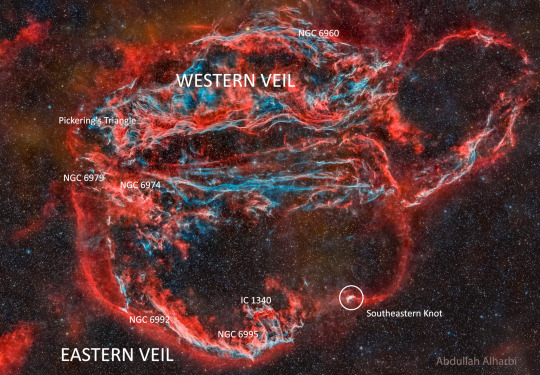

2025 June 2
Veil Nebula: Wisps of an Ancient Supernova Image Credit & Copyright: Abdullah Alharbi
Explanation: Wisps like this are all that remain visible of a Milky Way star. About 7,000 years ago that star exploded in a supernova, leaving the Veil Nebula. At the time, the expanding cloud was likely as bright as a crescent Moon, remaining visible for weeks to people living at the dawn of recorded history. Today, the resulting supernova remnant, also known as the Cygnus Loop, has faded and is now visible only through a small telescope directed toward the constellation of the Swan (Cygnus). The remaining Veil Nebula is physically huge, however, and even though it lies about 1,400 light-years distant, it covers over five times the size of the full Moon. The featured picture was taken in Kuwait in mid-2024 and features light emitted by hydrogen in red and oxygen in blue. In deep images of the complete Veil Nebula like this, even studious readers might not be able to identify the iconic filaments.
∞ Source: apod.nasa.gov/apod/ap250602.html
#astronomy#astronomy picture of the day#supernova remnant#Veil Nebula#Cygnus Loop#Western Veil#Witch's Broom Nebula#Caldwell 34#NGC 6960#Eastern Veil#Caldwell 33#NGC 6992#NGC 6995#Bat Nebula#IC 1340#Pickering's Triangle#Fleming's Triangular Wisp#NGC 6974#NGC 6979#Southwestern Knot
78 notes
·
View notes
Text
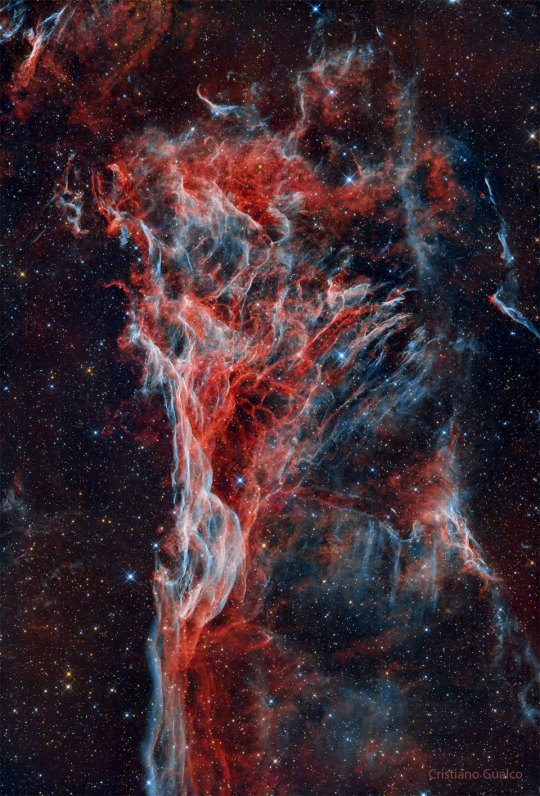
NGC 6979 Fleming's Triangular Wisp ©
#nasa#apod#astrophotography#stars#night sky#space#universe#solar system#astronomy#galaxy#cosmos#planet#supernova remnant#ngc 6979
2K notes
·
View notes
Photo

Flemings Triangular Wisp
Credits: Cristiano Gualco
103 notes
·
View notes
Text
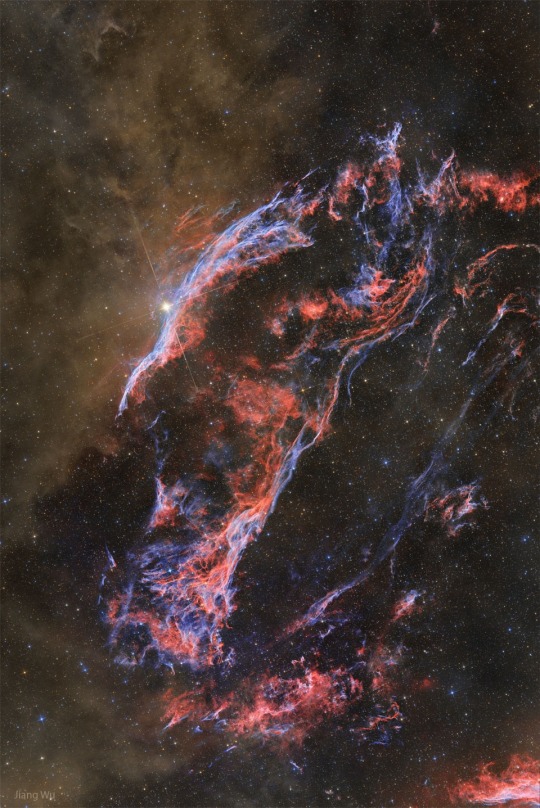
APOD October 18, 2023 Dust and the Western Veil Nebula It's so big it is easy to miss. The entire Veil Nebula spans six times the diameter of the full moon, but is so dim you need binoculars to see it. The nebula was created about 15,000 years ago when a star in the constellation of the Swan (Cygnus) exploded. The spectacular explosion would have appeared brighter than even Venus for a week - but there is no known record of it. Pictured is the western edge of the still-expanding gas cloud. Notable gas filaments include the Witch's Broom Nebula on the upper left near the bright foreground star 52 Cygni, and Fleming's Triangular Wisp (formerly known as Pickering's Triangle) running diagonally up the image middle. What is rarely imaged -- but seen in the featured long exposure across many color bands -- is the reflecting brown dust that runs vertically up the image left, dust likely created in the cool atmospheres of massive stars. © Jiang Wu
1 note
·
View note
Text

Fleming's Triangular Wisp
4K notes
·
View notes
Text
APOD: Flemings Triangular Wisp

Chaotic in appearance, these tangled filaments of shocked, glowing gas are spread across planet Earth's sky toward the constellation of Cygnus as part of the Veil Nebula. The Veil Nebula itself is a large supernova remnant, an expanding cloud born of the death explosion of a massive star. Light from the original supernova explosion likely reached Earth over 5,000 years ago. The glowing filaments are really more like long ripples in a sheet seen almost edge on, remarkably well separated into the glow of ionized hydrogen atoms shown in blue and oxygen in red hues. Also known as the Cygnus Loop and cataloged as NGC 6979, the Veil Nebula now spans about 6 times the diameter of the full Moon. The length of the wisp corresponds to about 30 light years, given its estimated distance of 2,400 light years. Often identified as Pickering's Triangle for a director of Harvard College Observatory, it is also named for its discoverer, astronomer Williamina Fleming, as Fleming's Triangular Wisp. via NASA https://ift.tt/374SXyV
https://ift.tt/3iQKuF7 from Blogger Expedition Space: Space Launch, Events, News
0 notes
Photo

Flemings Triangular Wisp via NASA https://apod.nasa.gov/apod/ap210727.html
0 notes
Photo

Flemings Triangular Wisp #NASA https://ift.tt/374SXyV
0 notes
Text
Dust and the Western Veil Nebula Image Credit & Copyright: Jiang Wu
Explanation: It's so big it is easy to miss. The entire Veil Nebula spans six times the diameter of the full moon, but is so dim you need binoculars to see it. The nebula was created about 15,000 years ago when a star in the constellation of the Swan (Cygnus) exploded. The spectacular explosion would have appeared brighter than even Venus for a week - but there is no known record of it. Pictured is the western edge of the still-expanding gas cloud. Notable gas filaments include the Witch's Broom Nebula on the upper left near the bright foreground star 52 Cygni, and Fleming's Triangular Wisp (formerly known as Pickering's Triangle) running diagonally up the image middle. What is rarely imaged -- but seen in the featured long exposure across many color bands -- is the reflecting brown dust that runs vertically up the image left, dust likely created in the cool atmospheres of massive stars.
October 18th, 2023
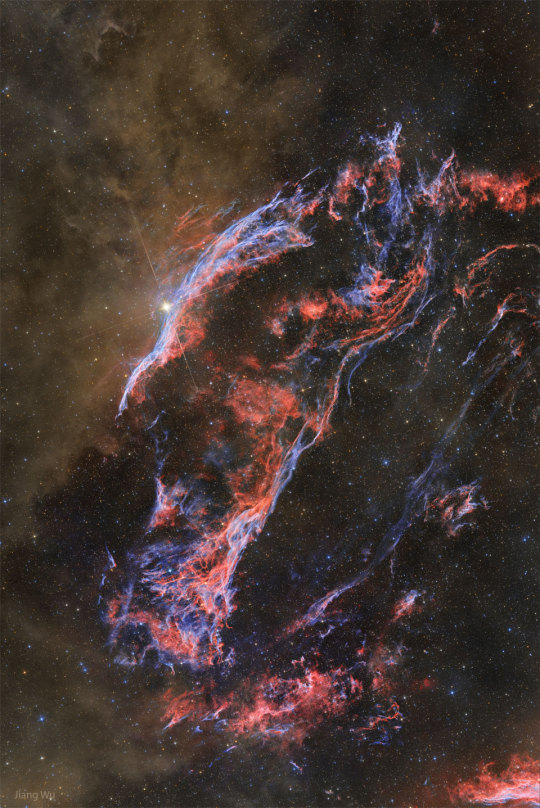
Western Veil Nebula l NASA APOD
723 notes
·
View notes
Photo

Flemings Triangular Wisp : Chaotic in appearance, these tangled filaments of shocked, glowing gas are spread across planet Earth's sky toward the constellation of Cygnus as part of the Veil Nebula. The Veil Nebula itself is a large supernova remnant, an expanding cloud born of the death explosion of a massive star. Light from the original supernova explosion likely reached Earth over 5,000 years ago. The glowing filaments are really more like long ripples in a sheet seen almost edge on, remarkably well separated into the glow of ionized hydrogen atoms shown in blue and oxygen in red hues. Also known as the Cygnus Loop and cataloged as NGC 6979, the Veil Nebula now spans about 6 times the diameter of the full Moon. The length of the wisp corresponds to about 30 light years, given its estimated distance of 2,400 light years. Often identified as Pickering's Triangle for a director of Harvard College Observatory, it is also named for its discoverer, astronomer Williamina Fleming, as Fleming's Triangular Wisp. via NASA
639 notes
·
View notes
Photo

"Flemings Triangular Wisp " Is the NASA Astronomy Picture of the Day of today, July 27, 2021
172 notes
·
View notes
Photo

Flemings Triangular Wisp via NASA https://ift.tt/374SXyV
114 notes
·
View notes
Photo
The entire Veil Supernova Remnant has an intricate filamentary structure, as seen here. This small triangle is often ignored in favor of the larger Eastern and Western arcs, which between them span about 3 degrees. But the structure is beautiful and complex, whichever part you choose to view.
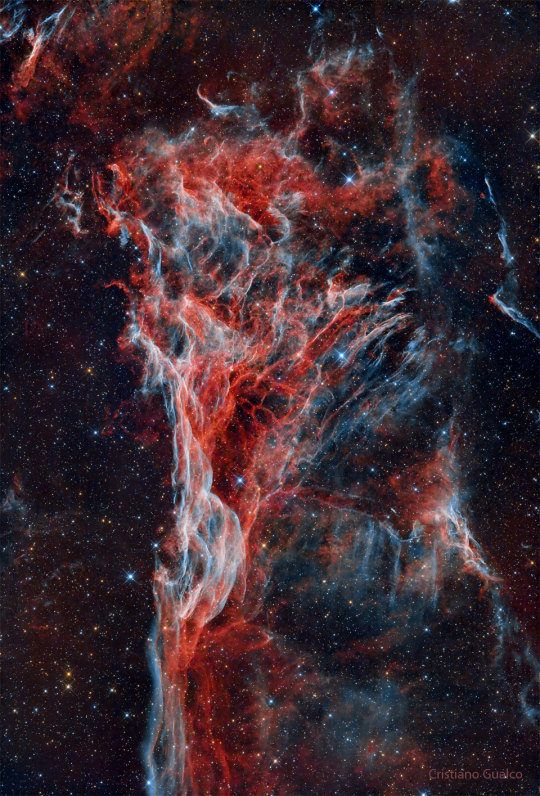
2023 November 21
Fleming’s Triangular Wisp Image Credit & Copyright: Cristiano Gualco
Explanation: These chaotic and tangled filaments of shocked, glowing gas are spread across planet Earth’s sky toward the constellation of Cygnus as part of the Veil Nebula. The Veil Nebula itself is a large supernova remnant, an expanding cloud born of the death explosion of a massive star. Light from the original supernova explosion likely reached Earth over 5,000 years ago. The glowing filaments are really more like long ripples in a sheet seen almost edge on, remarkably well separated into the glow of ionized hydrogen atoms shown in red and oxygen in blue hues. Also known as the Cygnus Loop and cataloged as NGC 6979, the Veil Nebula now spans about 6 times the diameter of the full Moon. The length of the wisp corresponds to about 30 light years, given its estimated distance of 2,400 light years. Often identified as Pickering’s Triangle for a director of Harvard College Observatory, it is perhaps better named for its discoverer, astronomer Williamina Fleming, as Fleming’s Triangular Wisp.
∞ Source: apod.nasa.gov/apod/ap231121.html
171 notes
·
View notes
Photo

Flemings Triangular Wisp via NASA
17 notes
·
View notes
Text

Chaotic in appearance, these tangled filaments of shocked, glowing gas are spread across planet Earth's sky toward the constellation of Cygnus as part of the Veil Nebula. The Veil Nebula itself is a large supernova remnant, an expanding cloud born of the death explosion of a massive star. Light from the original supernova explosion likely reached Earth over 5,000 years ago. The glowing filaments are really more like long ripples in a sheet seen almost edge on, remarkably well separated into the glow of ionized hydrogen atoms shown in blue and oxygen in red hues. Also known as the Cygnus Loop and cataloged as NGC 6979, the Veil Nebula now spans about 6 times the diameter of the full Moon. The length of the wisp corresponds to about 30 light years, given its estimated distance of 2,400 light years. Often identified as Pickering's Triangle for a director of Harvard College Observatory, it is also named for its discoverer, astronomer Williamina Fleming, as Fleming's Triangular Wisp.
https://apod.nasa.gov/apod/ap210727.html?fbclid=IwAR2pPtwW0U1CSPeTPUpwtEE7MKYhM7ajJRtPHmJG5ql-r5xJqEIUIPFzLMI
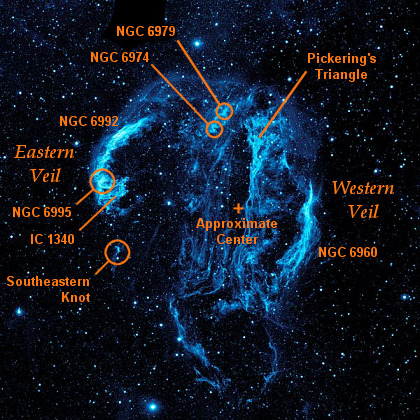
From Wikipedia
The Veil, Eastern and Western components, are part of a large supernova remnant known at the Cygnus Loop. Found in the constellation of Cygnus, the Swan. This picture is in ultraviolet light, from the GALEX orbiting telescope.
https://en.wikipedia.org/wiki/Cygnus_Loop
10 notes
·
View notes
